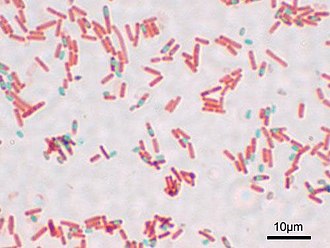Malachite green



Malachite Green is a synthetic dye used extensively in various industries, including the textile, aquaculture, and microbiology sectors. Its chemical formula is C23H25ClN2, and it appears as a green crystalline powder. Despite its widespread use, concerns have been raised about its safety, particularly in relation to its potential carcinogenic and mutagenic effects.
History[edit]
Malachite Green was first synthesized in the 19th century and has since been used in a variety of applications. Initially, it was primarily used as a dye for fabrics, leather, and paper. However, its antifungal and antibacterial properties led to its adoption in the fish farming industry as a treatment for fungal and parasitic infections.
Chemical Properties[edit]
Malachite Green is a triphenylmethane dye, characterized by its bright green color. It is soluble in water and alcohol, making it effective in various applications. The dye operates by binding to the nucleic acids within cells, thereby inhibiting the growth of bacteria and fungi.
Uses[edit]
Textile Industry[edit]
In the textile industry, Malachite Green has been used as a dye for wool, silk, and cotton. Its vibrant color and ability to adhere to fabrics made it a popular choice for clothing and other textile products.
Aquaculture[edit]
In aquaculture, Malachite Green has been employed to treat infections in fish and fish eggs. Its effectiveness against a wide range of fungal and parasitic infections made it a staple in fish farming. However, due to health concerns, its use has been restricted or banned in many countries.
Microbiology[edit]
In microbiology, Malachite Green is used as a staining agent in the Gram staining procedure, helping to differentiate between Gram-positive and Gram-negative bacteria.
Health and Environmental Concerns[edit]
The use of Malachite Green has been controversial due to its potential health and environmental impacts. Studies have shown that it can be carcinogenic and mutagenic, posing risks to both humans and wildlife. Its persistence in the environment and ability to accumulate in the tissues of aquatic organisms have led to calls for its use to be limited or phased out entirely.
Regulation[edit]
In response to these concerns, regulatory bodies in various countries have imposed restrictions on the use of Malachite Green. The European Union, the United States, and Canada, among others, have set limits on its presence in food products and have regulated its use in aquaculture.
Conclusion[edit]
While Malachite Green has played a significant role in various industries due to its dyeing and antimicrobial properties, its potential health and environmental risks cannot be ignored. The move towards safer alternatives reflects a growing awareness of the need to balance industrial and commercial benefits with public health and environmental protection.
Ad. Transform your life with W8MD's Budget GLP-1 injections from $75


W8MD offers a medical weight loss program to lose weight in Philadelphia. Our physician-supervised medical weight loss provides:
- Weight loss injections in NYC (generic and brand names):
- Zepbound / Mounjaro, Wegovy / Ozempic, Saxenda
- Most insurances accepted or discounted self-pay rates. We will obtain insurance prior authorizations if needed.
- Generic GLP1 weight loss injections from $75 for the starting dose.
- Also offer prescription weight loss medications including Phentermine, Qsymia, Diethylpropion, Contrave etc.
NYC weight loss doctor appointmentsNYC weight loss doctor appointments
Start your NYC weight loss journey today at our NYC medical weight loss and Philadelphia medical weight loss clinics.
- Call 718-946-5500 to lose weight in NYC or for medical weight loss in Philadelphia 215-676-2334.
- Tags:NYC medical weight loss, Philadelphia lose weight Zepbound NYC, Budget GLP1 weight loss injections, Wegovy Philadelphia, Wegovy NYC, Philadelphia medical weight loss, Brookly weight loss and Wegovy NYC
|
WikiMD's Wellness Encyclopedia |
| Let Food Be Thy Medicine Medicine Thy Food - Hippocrates |
Medical Disclaimer: WikiMD is not a substitute for professional medical advice. The information on WikiMD is provided as an information resource only, may be incorrect, outdated or misleading, and is not to be used or relied on for any diagnostic or treatment purposes. Please consult your health care provider before making any healthcare decisions or for guidance about a specific medical condition. WikiMD expressly disclaims responsibility, and shall have no liability, for any damages, loss, injury, or liability whatsoever suffered as a result of your reliance on the information contained in this site. By visiting this site you agree to the foregoing terms and conditions, which may from time to time be changed or supplemented by WikiMD. If you do not agree to the foregoing terms and conditions, you should not enter or use this site. See full disclaimer.
Credits:Most images are courtesy of Wikimedia commons, and templates, categories Wikipedia, licensed under CC BY SA or similar.
Translate this page: - East Asian
中文,
日本,
한국어,
South Asian
हिन्दी,
தமிழ்,
తెలుగు,
Urdu,
ಕನ್ನಡ,
Southeast Asian
Indonesian,
Vietnamese,
Thai,
မြန်မာဘာသာ,
বাংলা
European
español,
Deutsch,
français,
Greek,
português do Brasil,
polski,
română,
русский,
Nederlands,
norsk,
svenska,
suomi,
Italian
Middle Eastern & African
عربى,
Turkish,
Persian,
Hebrew,
Afrikaans,
isiZulu,
Kiswahili,
Other
Bulgarian,
Hungarian,
Czech,
Swedish,
മലയാളം,
मराठी,
ਪੰਜਾਬੀ,
ગુજરાતી,
Portuguese,
Ukrainian
